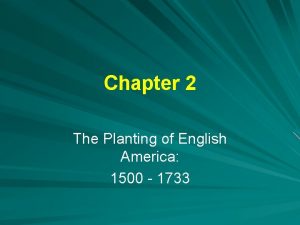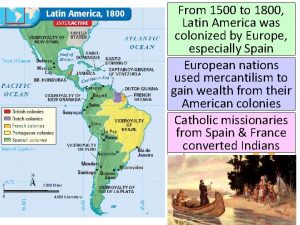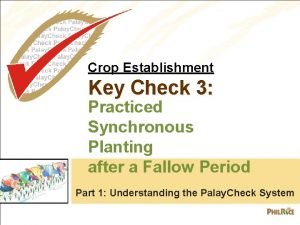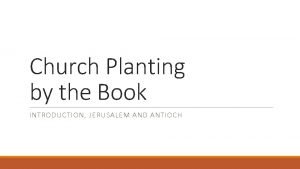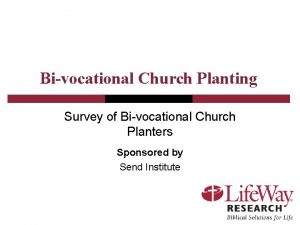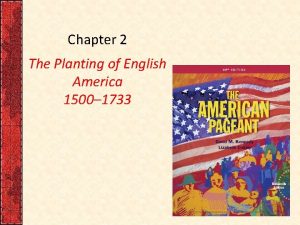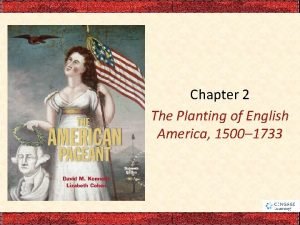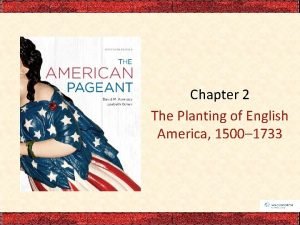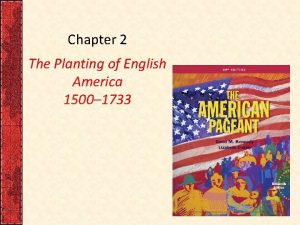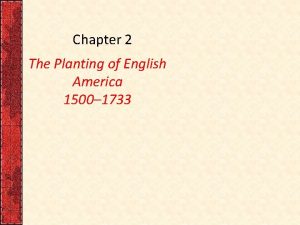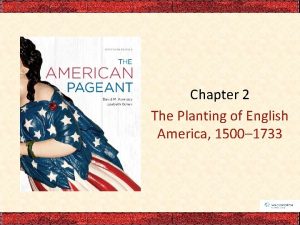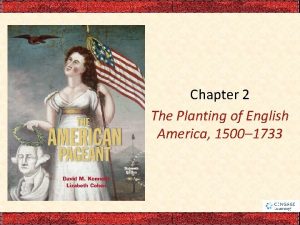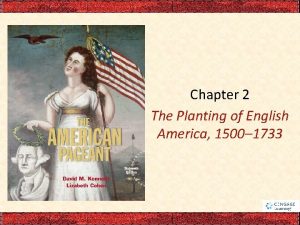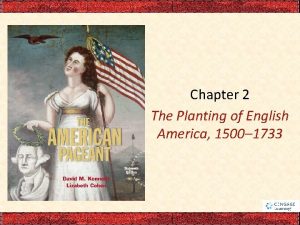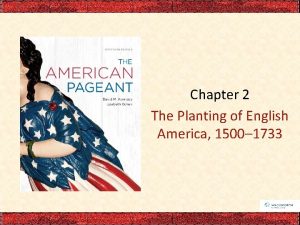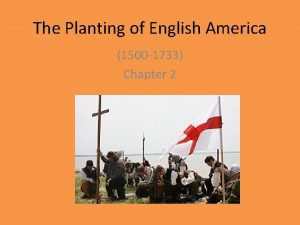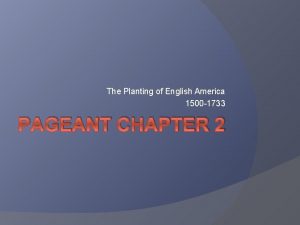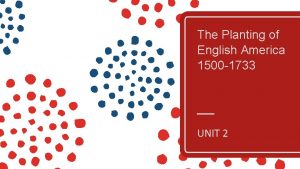Chapter 2 The Planting of English America 1500















- Slides: 15

Chapter 2 The Planting of English America: 1500 - 1733

England’s Imperial Stirrings England had too many internal issues during the 16 th cent to be concerned with the Spanish Empire In the first decades of the century, England was allied with Spain and took little interest in creating an overseas empire – Henry VIII’s break from the Catholic Church ended the alliance – 1558 – Elizabeth I taking the throne intensified the rivalry with Catholic Spain Catholic Ireland sought the help of Spain in attempting to break from England – Help never amounted to much – Elizabeth crushed the Irish, confiscated lands and “planted” Scottish & English landlords on these lands – Many English soldiers developed a deep contempt for the natives, an attitude they carried with them to the New World

Elizabeth Energizes England English buccaneers began swarming Atlantic shipping lanes – Technically at peace with Spain, Elizabeth promoted Protestantism and anything to weaken Spain – Most successful privateer was Sir Francis Drake, who was knighted, despite Spanish protest, on the deck of his own ship 1583 – Sir Humphrey Gilbert planned the first English settlement in NA, but he died at sea and the plans collapsed 1585 – Sir Walter Raleigh (Gilbert’s ½ brother) established Roanoke colony in of the coast of Virginia (the Lost Colony) 1588 – English defeat of the Spanish Armada – Philip II sought to end his Protestant problem, but was soundly defeated by the English (and North Atlantic weather) – Marked the decline of Spanish power in Europe – Established English naval dominance in North Atlantic & put them on the verge of building a world empire 1604 – James I signed a peace treaty with Spain

England on the Eve of Empire Population grew 33% between 1550 -1600 An economic depression provided America w/ its first immigrants – Landlords were enclosing fields to allow grazing land for sheep, farmers were losing land jobs – Laws of primogeniture (only eldest son inherits estates) caused ambitious younger sons (Raleigh, Gilbert, Drake) to seek fortunes elsewhere Those “lone wolf” adventurers were plagued by misfortune – The joint-stock company was perfected in the early 1600 s, allowing investors to pool their capital Peace with Spain allowed for English colonization w/o fear of Spanish encroachment Population supplied workers Unemployment, desire for religious freedom & a desire for resources and markets provided the motives Joint-stock companies provided the capital for ventures

England Plants Jamestown Seedling 1606 - the Virginia Co. received a charter from King James I for settlement in the New World – Virginia Co was only meant to last a couple of years, then be liquidated by its investors – Charter important b/c it guaranteed the same rights of Englishmen as if they stayed at home – Ironically, 150 yrs later their insistence on “rights of Englishmen” fueled resentment of the crown May 24, 1607 – the first permanent English settlement, Jamestown, is founded – Disease, malnutrition, starvation all caused hardships for the colonists – Settlers were unaccustomed to life in the wilderness, looking for gold instead of collecting provisions Virginia was saved from collapse by John Smith – 1608 – enacted the rule “he who shall not work, shall not eat”

Smith had been kidnapped in Dec 1607 – Indians led by the chieftain Powhatan captured him and put him through a mock execution – His daughter, Pocahontas, became an intermediary between the English and Indians A peace was upheld between the natives and colonists – Natives helped the colonists, but Englishmen still died in droves – Eating cats, dogs, & mice – Digging up the dead & killing and resorting to cannibalism Of the 400 English that came to Jamestown by 1609, only 60 survived the winter of 1609 -10 Spring 1610 – remaining colonists boarded ships headed back to England, only to be met by the new governor, Lord De La Warr – De La Warr led through military force and broke the peace w/ the Indians – By 1625, only 1200 of 8000 colonists had survived

Cultural Clash in the Chesapeake Powhatan dominated the native people of the James River area – Served as chieftain of a dozen tribes, referred to as Powhatan’s Confederacy – The English called all Indians in the area Powhatans 1610 – when De La Warr arrived, he had orders from the Virginia Co. to take the fight to the natives – Introduced “Irish tactics” against Indians (raided villages, burned houses, confiscated provisions, & torched fields) 1614 – the First Anglo-Powhatan War was ended with the marriage of Pocahontas to colonist John Rolfe 1622 – Indian attacks left 347 settlers dead and called for an ongoing English response 1644 -46 – Second Anglo-Powhatan War: failed last attempt to push the English out of Chesapeake area By 1685, the Powhatans were considered extinct due to 3 Ds: disease, disorganization, & disposability

The Indians’ New World European civilization disrupted life for Native Americans on a large scale – Introduction of the horse caused migration onto the Great Plains in the 18 th cent – The Lakota Sioux were forest dwellers that transitioned to life as nomadic hunters on the open grassland Disease wiped out cultures and created new ones – Tribal elders passed on culture and tradition orally – With the older generations gone, tribes had to reinvent themselves Forced migration sometimes mixed remnants of tribes together, forming new nations (Catabwa) European trade – Firearms intensified competition for hunting grounds and thus led to warfare Indians farther off the coast had more time to prepare and strengthen themselves against European expansion

Virginia: Child of Tobacco John Rolfe – husband of Pocahontas and father of the tobacco industry – – Perfected method of raising and curing the plant Saved the Virginia colony economically European demand for tobacco was very high As the colonists pushed west to expand farmland, they began encroaching on Indian territory Tobacco is hard on soil, when planted in the same ground year after year – Affected quality of crops, thus creating a fluctuating market – Also promoted the plantation system and created a demand for physical laborers – 1619 – records indicate 20 Africans from a Dutch warship off the coast of Jamestown – By 1700, African slaves made up 14% of colonial population 1624 – James I revokes Virginia’s charter & it becomes a royal colony

Maryland: Catholic Haven 1634 - founded by Lord Baltimore, a prominent catholic English law still heavily discriminated against Catholics His plan was to grant large estates to his largely catholic family – Settlers were only willing to some if they had the opportunity to own their own land – Tensions arose between catholic land barons and the largely protestant planters Like Virginia, Maryland depended on white indentured servants for labor – African slaves were not imported in large numbers until the end of the 17 th century Baltimore had permitted the freedom of worship from the beginning, but large numbers of protestant settlers threatened a situation similar to England for Catholics 1649 – Act of Toleration – guaranteed religious toleration to all Christians, but promised the death penalty to non-Christians – Actually reduced level of toleration but provided comfort to the Catholic minority

The West Indies While planting the first colonies in N. A. , England was also busy colonizing the West Indies Spain had loosened its grip on the Caribbean by the early 1600 s 1655 – England secured Jamaica, jewel of the sugar trade Tobacco was a poor man’s crop, sugar cane was only for wealthy investors – – – Had to be planted over large area to produce viable quantities Elaborate refining process at a sugar mill Highly labor and capital intensive Enormous numbers of African slaves brought to the Caribbean – 250, 000 from 1640 -1690 – 1700 – African slaves outnumbered white settlers 4 to 1 To keep such a disproportionate slave population in check, legal codes were created like The Barbados Slave Code (1661) – Would serve as a model for similar codes on the mainland Sugar plantations soon crowded out other forms of Caribbean agriculture & the islands became dependant on the mainland for food

Colonizing the Carolinas The English Civil War (1642 -1651) and subsequent restoration, halted colonization for a time 1670 – Carolina (named after King Charles II) founded when the king gave an expanse of land south of Virginia, cutting across the continent to the Pacific Ocean, to 8 of his favorite nobles (the Lords Proprietors) The initial plan was to grow foodstuffs for the sugar plantations in the Caribbean Many initial settlers were displaced farmers from Barbados – Brought their slave system with them – A native slave trade developed despite the protests of the Lords Proprietors Rice became the chief export, which caused plantation owners to pay a premium for West African slaves that knew how to harvest rice Charles Town (Charleston, SC) became an aristocratic center and the busiest seaport of the south

Emergence of North Carolina The aristocratic trappings of Virginia had caused poor outcasts & religious dissenters to drift south into the wilderness of Carolina – Had no legal right to the soil – Raised tobacco on small farms w/o need for slaves Poor but hard-working, the inhabitants were viewed by snobbish neighbors north and south as outcasts 1712 – officially separated from South Carolina and both promptly became royal colonies North Carolina and Rhode Island shared several similarities – Most democratic, most independent-minded, & least aristocratic of the original 13 colonies The Carolinas both had their share of bloody relations with Native Americans By 1720, costal Indian tribes were all but wiped out but stronger inland tribes kept British settlement east of the Appalachian Mts for 50 yrs

Late-Coming Georgia: The Buffer Colony Formally founded in 1733 Last of the 13 original colonies Slow growing & sparsely populated Intended to serve as a buffer between SC, Spanish Florida, & French Louisiana Named after King George II Produced silk and wine & served as a haven for English imprisoned for debt James Oglethorpe repelled Spanish attacks while personally saving the colony from collapse by mortgaging his own personal holdings All Christians, except Catholics, were equally tolerated – Missionaries did flock to Georgia to work among the debtors and Indians (most prominent was John Wesley, founder of Methodism)

The Plantation Colonies Certain characteristics were shared by all southern mainland colonies – All devoted in some degree to agricultural outposts – Profitable stable crops are the rule: tobacco and rice – Slavery in all plantation colonies, but not Georgia until 1750 The scattered establishment of settlements and plantation farms made the establishment of churches and schools difficult and expensive All plantation colonies permitted some form of religious toleration All colonies were expansionary to some extent, – Soil depletion from tobacco farming drove settlers to push westward in search of land & invited further conflicts with Indians
 The planting of english america
The planting of english america Latin america 1500 to 1800
Latin america 1500 to 1800 America africa and europe before 1500
America africa and europe before 1500 North america, family histories, 1500-2000
North america, family histories, 1500-2000 Middle english period 1066-1500
Middle english period 1066-1500 Rap of the map of the us
Rap of the map of the us Asia europe north america
Asia europe north america Repetition in let america be america again
Repetition in let america be america again Why called latin america
Why called latin america Happening body art
Happening body art How does iago plant the seed of jealousy in othello?
How does iago plant the seed of jealousy in othello? How does iago plant the seed of jealousy in othello
How does iago plant the seed of jealousy in othello Synchronous planting is an example of
Synchronous planting is an example of Introduction to church planting
Introduction to church planting Bivocational church planting
Bivocational church planting Objectives of flowers
Objectives of flowers
